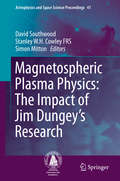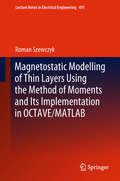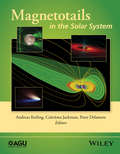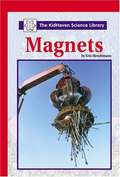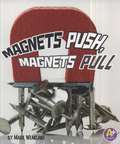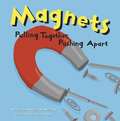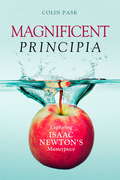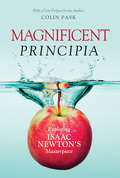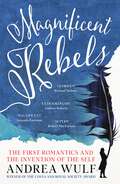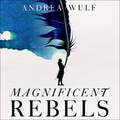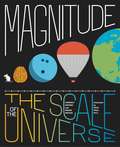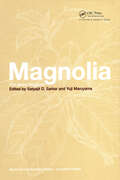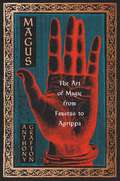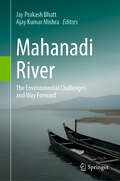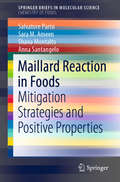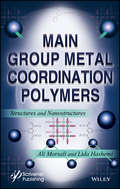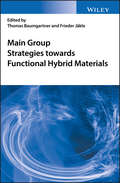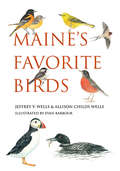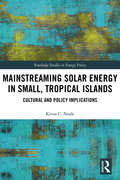- Table View
- List View
Magnetospheric Plasma Physics: The Impact of Jim Dungey's Research
by Simon Mitton David Southwood Stanley W. H. Cowley FRSThis book makes good background reading for much of modern magnetospheric physics. Its origin was a Festspiel for Professor Jim Dungey, former professor in the Physics Department at Imperial College on the occasion of his 90th birthday, 30 January 2013. Remarkably, although he retired 30 years ago, his pioneering and, often, maverick work in the 50's through to the 70's on solar terrestrial physics is probably more widely appreciated today than when he retired. Dungey was a theoretical plasma physicist. The book covers how his reconnection model of the magnetosphere evolved to become the standard model of solar-terrestrial coupling. Dungey's open magnetosphere model now underpins a holistic picture explaining not only the magnetic and plasma structure of the magnetosphere, but also its dynamics which can be monitored in real time. The book also shows how modern day simulation of solar terrestrial coupling can reproduce the real time evolution of the solar terrestrial system in ways undreamt of in 1961 when Dungey's epoch-making paper was published. Further contributions on current Earth magnetosphere research and space plasma physics included in this book show how Dungey's basic ideas have remained explanative 50 years on. But the Festspiel also introduced some advances that possibly Dungey had not foreseen. One of the contributions presented in this book is on the variety of magnetospheres of the solar system which have been seen directly during the space age, discussing the variations in spatial scale and reconnection time scale and comparing them in respect of Earth, Mercury, the giant planets as well as Ganymede.
Magnetostatic Modelling of Thin Layers Using the Method of Moments And Its Implementation in Octave/Matlab (Lecture Notes In Electrical Engineering #491)
by Roman SzewczykThis book presents an efficient and robust method of modelling the magnetostatic properties of different technical elements, especially thin layers for magnetic sensors. The solutions presented utilise the principles of the method of moments. However, the principles have been developed both from the point of view of physical analyses as well as from the point of view of numerical optimisation. To enable cost-efficient use of the solutions for commercial applications in industry, the proposed method was implemented as a code optimised for use in the open-source OCTAVE environment. The scripts can be also used with MATLAB software, which is more user friendly, especially for less experienced users.
Magnetostatic Waves in Inhomogeneous Fields
by V.G. Shavrov V.I. ShcheglovMagnetostatic waves (MSWs) in magnetodielectric media are fundamental for the creation of various highly efficient devices for analog information processing in the microwave range. These devices include various filters, delay lines, phase shifters, frequency converters, nonreciprocal and nonlinear devices, and others. Magnetostatic Waves in Inhomogeneous Fields examines magnetostatic waves and their distribution in non-uniformly magnetized films and structures. The propagation of magnetostatic waves in magnetodielectric environments is accompanied by numerous and very diverse physical effects, sharply distinguishing them from ordinary electromagnetic waves in isotropic media. The authors address dispersion properties and noncollinearity of phase and group velocity vectors, as well as non-reciprocal propagation. Key Features Offers mathematical tools used in the calculation of properties of magnetostatic waves Includes a current literature review of magnetostatic waves and domain structures in garnet–ferrite films Considers the issue of converting magnetostatic waves into electromagnetic ones
Magnetotails in the Solar System
by Andreas Keiling Peter Delamere Caitríona JackmanAll magnetized planets in our solar system (Mercury, Earth, Jupiter, Saturn, Uranus, and Neptune) interact strongly with the solar wind and possess well developed magnetotails. It is not only the strongly magnetized planets that have magnetotails. Mars and Venus have no global intrinsic magnetic field, yet they possess induced magnetotails. Comets have magnetotails that are formed by the draping of the interplanetary magnetic field. In the case of planetary satellites (moons), the magnetotail refers to the wake region behind the satellite in the flow of either the solar wind or the magnetosphere of its parent planet. The largest magnetotail of all in our solar system is the heliotail, the "magnetotail" of the heliosphere. The variety of solar wind conditions, planetary rotation rates, ionospheric conductivity, and physical dimensions provide an outstanding opportunity to extend our understanding of the influence of these factors on magnetotail processes and structures. Collectively, Magnetotails in the Solar System brings together for the first time in one book a collection of tutorials and current developments addressing different types of magnetotails. As a result, this book should appeal to a broad community of space scientists, and it should also be of interest to astronomers who are looking at tail-like structures beyond our solar system.
Magnets
by Kris HirschmannExplains what magnets are, how they changed the world, how they are used in everyday life, and high-tech applications for magnets. Includes bibliographical references and index.
Magnets
by Wiley BlevinsPhonics Readers is a recognized leader in helping you teach phonics and phonemic awareness, within the context of content-area reading. Content area focus: Magnets; Phonics Skills: final e, l-blends
Magnets Push, Magnets Pull
by David A. AdlerExplore the fascinating field of magnetism with this interactive picture book for young learners.Magnetism is all around us--even the earth is a giant magnet. A world without magnets would be a world without cell phones, computers, and more! Trusted children's nonfiction author David A. Adler covers the basics of magnetism, including compasses, for aspiring scientists. Hands-on experiments are smartly woven into the narrative. Want to test out the strength of a magnet? All you need is a bowl of water and some paper clips! Anna Raff's lively art illustrates scientific concepts clearly, with the added fun of two siblings and their dog exploring and learning together. Back matter includes a glossary that defines such terms as attraction, pole, electromagnetism, force, and more. Suggested activities on how to make your own magnet are also included. Finalist for the AAAS/Subaru SB&F Prize for Excellence in Science Books
Magnets Push, Magnets Pull (Science Starts)
by Mark WeaklandCan a magnet really crush a car? How do magnets stick to the fridge without tape or glue? Discover the wonder and science of magnets in Magnets Push, Magnets Pull.
Magnets and Motors: Student Investigations
by National Science Resources CenterNIMAC-sourced textbook
Magnets: Pulling Together, Pushing Apart (Amazing Science)
by Natalie M. RosinskyHave you ever wondered what makes magnets work? Magnets, by Natalie M. Rosinsky introduces many different kinds of magnets, such as motors, compasses, and Earth's magnetic poles. Clear text, vivid illustrations, fun facts, and simple experiments make this book a great introduction to magnets.
Magnificent Principia
by Colin PaskNobel laureate Steven Weinberg has written that "all that has happened since 1687 is a gloss on the Principia." Now you too can appreciate the significance of this stellar work, regarded by many as the greatest scientific contribution of all time. Despite its dazzling reputation, Isaac Newton's Philosophiae Naturalis Principia Mathematica, or simply the Principia, remains a mystery for many people. Few of even the most intellectually curious readers, including professional scientists and mathematicians, have actually looked in the Principia or appreciate its contents. Mathematician Pask seeks to remedy this deficit in this accessible guided tour through Newton's masterpiece. Using the final edition of the Principia, Pask clearly demonstrates how it sets out Newton's (and now our) approach to science; how the framework of classical mechanics is established; how terrestrial phenomena like the tides and projectile motion are explained; and how we can understand the dynamics of the solar system and the paths of comets. He also includes scene-setting chapters about Newton himself and scientific developments in his time, as well as chapters about the reception and influence of the Principia up to the present day.
Magnificent Principia: Exploring Isaac Newton's Masterpiece
by Colin PaskWill help you appreciate and understand the significance of Isaac Newton's masterpiece--what many regard as the greatest scientific contribution of all time.Despite its dazzling reputation, Isaac Newton's Philosophiae Naturalis Principia Mathematica, or simply the Principia, remains a mystery for many people. Few of even the most intellectually curious readers, including professional scientists and mathematicians, have actually looked in the Principia or appreciated its contents.Mathematician Colin Pask seeks to remedy this deficit with this accessible guided tour through Newton's masterpiece. Using the final edition of the Principia, Pask clearly demonstrates how it sets out Newton's (and now our) approach to science, how the framework of classical mechanics is established, how terrestrial phenomena like the tides and projectile motion are explained, and how we can understand the dynamics of the solar system and the paths of comets. He also includes scene-setting chapters about Newton himself and scientific developments in his time, as well as chapters about the reception and influence of the Principia up to the present day.Now in paperback with a new preface, this lucidly written work makes Newton's landmark achievement comprehensible to lay readers.
Magnificent Rebels: The First Romantics and the Invention of the Self
by Andrea Wulf'Elegantly written, deeply researched and totally gripping' SIMON SEBAG MONTEFIOREIn the 1790s an extraordinary group of friends changed the world. Disappointed by the French Revolution's rapid collapse into tyranny, what they wanted was nothing less than a revolution of the mind. The rulers of Europe had ordered their peoples how to think and act for too long. Based in the small German town of Jena, through poetry, drama, philosophy and science, they transformed the way we think about ourselves and the world around us. They were the first Romantics.Their way of understanding the world still frames our lives and being.We're still empowered by their daring leap into the self. We still think with their minds, see with their imagination and feel with their emotions. We also still walk the same tightrope between meaningful self-fulfilment and destructive narcissism, between the rights of the individual and our role as a member of our community and our responsibilities towards future generations who will inhabit this planet. This extraordinary group of friends changed our world. It is impossible to imagine our lives, thoughts and understanding without the foundation of their ground-breaking ideas.
Magnificent Rebels: The First Romantics and the Invention of the Self
by Andrea WulfFrom the Costa Prize-winning author of The Invention of Nature, Magnificent Rebels is a riveting, eye-opening biography of the first Romantics: a revolutionary group of friends based in the small German town of Jena whose modern ideas transformed society and the way we lead our lives today.In the 1790s an extraordinary group of friends changed the world. Disappointed by the French Revolution's rapid collapse into tyranny, what they wanted was nothing less than a revolution of the mind. The rulers of Europe had ordered their peoples how to think and act for too long. Based in the small German town of Jena, through poetry, drama, philosophy and science, they transformed the way we think about ourselves and the world around us. They were the first Romantics.Their way of understanding the world still frames our lives and being. We're still empowered by their daring leap into the self. We still think with their minds, see with their imagination and feel with their emotions. We also still walk the same tightrope between meaningful self-fulfilment and destructive narcissism, between the rights of the individual and our role as a member of our community and our responsibilities towards future generations who will inhabit this planet. This extraordinary group of friends changed our world. It is impossible to imagine our lives, thoughts and understanding without the foundation of their ground-breaking ideas.(P) 2022 Hodder & Stoughton Limited
Magnitude: The Scale of the Universe
by Megan Watzke Kimberly ArcandIn the tradition of illustrated science bestsellers, like Thing Explainer and harkening back to the classic film The Powers of Ten, this unique, fully-illustrated, four-color book explores and visualizes the concept of scale in our universe. In Magnitude, Kimberly Arcand and Megan Watzke take us on an expansive journey to the limits of size, mass, distance, time, temperature in our universe, from the tiniest particle within the structure of an atom to the most massive galaxy in the universe; from the speed at which grass grows (about 2 to 6 inches a month) to the speed of light. Fully-illustrated with four-color drawings and infographics throughout and organized into sections including Size and Amount (Distance, Area, Volume, Mass, Time, Temperature), Motion and Rate (Speed, Acceleration, Density, Rotation), and Phenomena and Processes (Energy, Pressure, Sound, Wind, Computation), Magnitude shows us the scale of our world in a clear, visual way that our relatively medium-sized human brains can easily understand.
Magnolia: The Genus Magnolia
by Satyajit D. Sarker Yuji MaruyamaThe genus Magnolia consists of several medicinally important species most of which come from Far East Asia. Many species of this genus have traditionally been used in China and Japan to treat various illnesses from simple headaches to complicated cancer, and because of their versatility have more recently been incorporated into commercially success
Magus: The Art of Magic from Faustus to Agrippa
by Anthony GraftonA revelatory new account of the magus—the learned magician—and his place in the intellectual, social, and cultural world of Renaissance Europe.In literary legend, Faustus is the quintessential occult personality of early modern Europe. The historical Faustus, however, was something quite different: a magus—a learned magician fully embedded in the scholarly currents and public life of the Renaissance. And he was hardly the only one. Anthony Grafton argues that the magus in sixteenth-century Europe was a distinctive intellectual type, both different from and indebted to medieval counterparts as well as contemporaries like the engineer, the artist, the Christian humanist, and the religious reformer. Alongside these better-known figures, the magus had a transformative impact on his social world.Magus details the arts and experiences of learned magicians including Marsilio Ficino, Pico della Mirandola, Johannes Trithemius, and Heinrich Cornelius Agrippa. Grafton explores their methods, the knowledge they produced, the services they provided, and the overlapping political and social milieus to which they aspired—often, the circles of kings and princes. During the late fifteenth and early sixteenth centuries, these erudite men anchored debates about licit and illicit magic, the divine and the diabolical, and the nature of “good” and “bad” magicians. Over time, they turned magic into a complex art, which drew on contemporary engineering as well as classical astrology, probed the limits of what was acceptable in a changing society, and promised new ways to explore the self and exploit the cosmos.Resituating the magus in the social, cultural, and intellectual order of Renaissance Europe, Grafton sheds new light on both the recesses of the learned magician’s mind and the many worlds he inhabited.
Mahale Chimpanzees
by Nakamura, Michio and Hosaka, Kazuhiko and Itoh, Noriko and Zamma, Koichiro Michio Nakamura Kazuhiko Hosaka Noriko Itoh Koichiro ZammaLong-term ecological research studies are rare and invaluable resources, particularly when they are as thoroughly documented as the Mahale Mountain Chimpanzee Project in Tanzania. Directed by Toshisada Nishida from 1965 until 2011, the project continues to yield new and fascinating findings about our closest neighbour species. In a fitting tribute to Nishida's contribution to science, this book brings together fifty years of research into one encyclopaedic volume. Alongside previously unpublished data, the editors include new translations of Japanese writings throughout the book to bring previously inaccessible work to non-Japanese speakers. The history and ecology of the site, chimpanzee behaviour and biology, and ecological management are all addressed through firsthand accounts by Mahale researchers. The authors highlight long-term changes in behaviour, where possible, and draw comparisons with other chimpanzee sites across Africa to provide an integrative view of chimpanzee research today.
Mahanadi River: The Environmental Challenges and Way Forward
by Ajay Kumar Mishra Jay Prakash BhattThis book covers an overview of the Mahanadi River basin, spanning a total area of 141,581 square kilometers and extending across the states of Chhattisgarh (52.42%), Odisha (47.14%), Maharashtra (0.23%), Madhya Pradesh (0.11%), and Jharkhand (0.1%). It delves into the basin's hydro-development scenario, biodiversity, water quality, and sand mining, elucidating the pivotal role of the river in economic, social, and environmental viability of the eastern region of India. This volume emphasizes the environmental consequences stemming from unsustainable human activities such as river regulation, burgeoning settlements, sand mining, overfishing, and more. The Mahanadi River basin has been less explored for its biodiversity and environmental aspects compared to other prominent river basins like Ganga, Indus, Western Ghats, Godavari, and Krishna. This book seeks to fill this gap, offering new insights into the Mahanadi basin. The chapters address all dimensions of the environment, including social, ecological, engineering, and economic aspects, making it a multidisciplinary work. The book is tailored for audiences with backgrounds in social studies, engineering, biodiversity, and ecology.
Maillard Reaction in Foods: Mitigation Strategies and Positive Properties (SpringerBriefs in Molecular Science)
by Salvatore Parisi Sara M. Ameen Anna Santangelo Shana MontaltoThis book provides an overview of mitigation strategies and positive health effects of Maillard Reaction products in the contexts of food processing and storage. The effects of Maillard Reactions can vary considerably: while on the one hand certain sensorial alterations and influences on color, flavor and odor may be desirable, Maillard Reactions can also result in potentially harmful and toxic products (e.g. furfurals, furosines, or acrylamide). This book discusses possible mitigation strategies for the reduction of toxic reaction products, including the addition of enzymes or antioxidants, reducing sugars, and encapsulation approaches, as well as new processing strategies, such as high-pressure, radio-frequency, ultrahigh-temperature, or Ohmic heating methods. The book also illustrates that certain Maillard products can even produce positive health effects, e.g. antimicrobial or anticarcinogenic effects. The methods described here can serve as a blueprint for promoting the formation of beneficial compounds and reducing / avoiding toxic substances, offering essential strategies and methods.
Main Group Metal Coordination Polymers: Structures and Nanostructures
by Ali Morsali Lida HashemiCoordination polymer is a general term used to indicate an infinite array composed of metal ions which are bridged by certain ligands among them. This incorporates a wide range of architectures including simple one-dimensional chains with small ligands to large mesoporous frameworks. Generally, the formation process proceeds automatically and, therefore, is called a self-assembly process. In general, the type and topology of the product generated from the self-assembly of inorganic metal nodes and organic spacers depend on the functionality of the ligand and valences and the geometric needs of the metal ions used. In this book the authors explain main group metal coordination polymer in bulk and nano size with some of their application, synthesis method and etc, The properties of these efficient materials are described at length including magnetism (long-range ordering, spin crossover), porosity (gas storage, ion and guest exchange), non-linear optical activity, chiral networks, reactive networks, heterogeneous catalysis, luminescence, multifunctional materials and other properties.
Main Group Strategies for Functional Hybrid Materials
by Thomas Baumgartner Frieder JaekleShowcases the highly beneficial features arising from the presence of main group elements in organic materials, for the development of more sophisticated, yet simple advanced functional materials Functional organic materials are already a huge area of academic and industrial interest for a host of electronic applications such as Organic Light-Emitting Diodes (OLEDs), Organic Photovoltaics (OPVs), Organic Field-Effect Transistors (OFETs), and more recently Organic Batteries. They are also relevant to a plethora of functional sensory applications. This book provides an in-depth overview of the expanding field of functional hybrid materials, highlighting the incredibly positive aspects of main group centers and strategies that are furthering the creation of better functional materials. Main Group Strategies towards Functional Hybrid Materials features contributions from top specialists in the field, discussing the molecular, supramolecular and polymeric materials and applications of boron, silicon, phosphorus, sulfur, and their higher homologues. Hypervalent materials based on the heavier main group elements are also covered. The structure of the book allows the reader to compare differences and similarities between related strategies for several groups of elements, and to draw crosslinks between different sections. The incorporation of main group elements into functional organic materials has emerged as an efficient strategy for tuning materials properties for a wide range of practical applications Covers molecular, supramolecular and polymeric materials featuring boron, silicon, phosphorus, sulfur, and their higher homologues Edited by internationally leading researchers in the field, with contributions from top specialists Main Group Strategies towards Functional Hybrid Materials is an essential reference for organo-main group chemists pursuing new advanced functional materials, and for researchers and graduate students working in the fields of organic materials, hybrid materials, main group chemistry, and polymer chemistry.
Maine's Favorite Birds
by Jeffrey V. Wells Allison Childs Wells Evan BarbourFrom lush forests and rocky coastlines to lakes, mountains, and rolling fields, spectacular natural beauty and diverse habitats make Maine a wonderful place for seeing and hearing some of North America's most iconic birds. This fresh new book highlights the birds that are loved by Mainers and essential to why millions of tourists visit each year. Written by well-known birders and native Mainers, and based on their years of experience answering questions, leading bird walks, and teaching people about birds, Maine's Favorite Birds puts the focus on Maine's most-loved and best-known birds. This makes the book uniquely suited to bird enthusiasts who want to identify and learn more about the birds around them without the expense and confusion of more advanced field guides. Maine's Favorite Birds features each bird beautifully illustrated in large format, accompanied by clear and concise identification tips, habitat references, and easy-to-remember song descriptions. It also includes birding hot spots and ways birders can put their observations to use for science and conservation. Maine's Favorite Birds is perfect for everyone from kids to grandparents, parents to teachers, Mainers and tourists alike anyone who wants to know and better appreciate the birds they see in backyards, parks, wild areas, and nature preserves.
Mainstreaming Solar Energy in Small, Tropical Islands: Cultural and Policy Implications (Routledge Studies in Energy Policy)
by Kiron C. NealeThis book explores how cultural considerations can improve policymaking to achieve mainstream solar energy in small, tropical islands. Focusing on Trinidad, Barbados and Oʻahu, Kiron C. Neale looks at how culture can affect and be affected by the policies that support the household adoption of two key energy technologies: solar water heating and photovoltaics. Drawing on interviews with residents and energy officials, and an examination of the institutional, socio-economic and physical factors that affect energy systems such as governance structures and energy resource availability, the author explores themes including the impact of insularity on energy transitions and behavioural and cultural change. Overall, this book rebrands policies as instruments of cultural change and puts forward recommendations applicable to all small, tropical islands. Following the islands’ transition to renewable energy, this book will be of great interest to scholars of energy policy, energy transitions, climate change, cultural studies and small states development, as well as industry professionals working on energy policy implementation.
